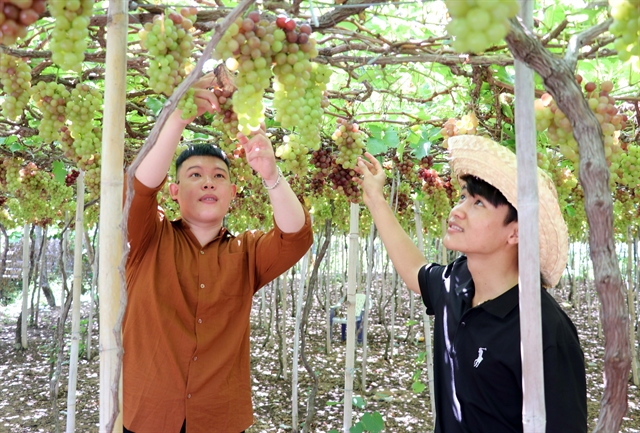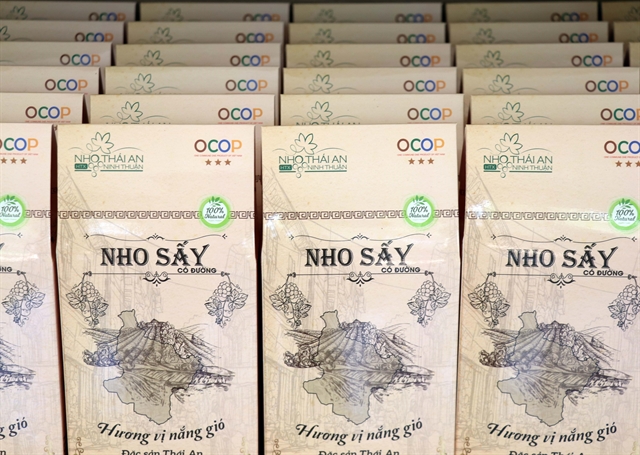 Society
Society


|
| Tourists from HCM City visit a grape orchard in Thái An Hamlet in Khánh Hòa Province’s Vĩnh Hải Commune. — VNA/VNS Photo Công Thử |
KHÁNH HÒA — Khánh Hòa Province is expanding its grape farming area, applying advanced technology, and strengthening the production–processing–consumption chain, with a focus on export markets and sustainable development.
The central province, the country’s largest grape producer, is actively planning farming zones, prioritising areas with geographical indications, developing specialised cultivation, and promoting production linkages.
Grapes are a distinctive crop well-suited to the dry conditions in the southern part of the province, offering high economic returns.
As of the end of last year, the province had over 1,100ha under the fruit.
Key varieties include red cardinal, NH01-48 (green grape), NH01-152 (pink finger grape), Black Queen, and wine grapes.
Several new seedless, high-quality types such as NH01-205 (mẫu đơn grape), NH04-195 (hạ đen grape), and NH04-102 (black finger grape) are being trialled and expanded.
Phạm Văn Trí, 43, of Thái An Village in Vĩnh Hải Commune, said 85 per cent of locals grow grapes.
His family cultivates 5,000sq.m of grapes and is expanding farming of new varieties such as candy grapes, he said.
Prices currently range from VNĐ50,000 to 250,000 (US$1.9–9.6) per kilogramme, depending on the variety, he said.
They have remained stable in recent years because of clean growing practices, and rising demand ensures consistently high incomes for farmers, he added.
Nguyễn Khắc Phòng, director of the Thái An Agricultural Service Co-operative, said grapes are the most valuable crop in the area, generating substantial income for growers.
The use of technical advances and high-tech methods, along with the cultivation of new seedless, high-quality varieties, has increased yields to over 250 tonnes per hectare, he added.
The province has developed several concentrated grape-growing villages, including Thái An, Xuân Hải, Văn Hải, and Nho Lâm, with more than 254ha certified as meeting VietGAP standards.
These areas not only produce efficiently but also attract large numbers of tourists.
According to the provincial Department of Agriculture and Environment, over 10 establishments, 30 private enterprises and 200 households involved in producing and processing grape products.
These include syrups, wines, juices, raisin, and jams, which are highly popular in the market.

|
| Dried grapes made by the Thái An General Agriculture Co-operative in Vĩnh Hải Commune have been recognised as a three-star product under the country’s “One Commune – One Product” programme. — VNA/VNS Photo Công Thử |
To support sustainable, large-scale development and increase value, the province is actively soliciting investment and expanding and innovating production.
It is strengthening cooperation between farmers, scientists and businesses, encouraging the application of high-tech solutions from cultivation to processing.
Scientists and research institutes are being encouraged to create new seedless, high-quality grape varieties suited to local conditions while reducing intermediary costs.
Phan Công Kiên, deputy director of the province-based Nha Hố Research Institute for Cotton and Agriculture Development, said: “All grape varieties transferred to farmers originate from the institute. The institute has researched and created new grape varieties that meet market requirements, create added value and profitability for both production and processing.”
It is currently preserving and cultivating more than 230 new grape varieties in trial fields. These offer high yields and are resistant to harsh weather and common diseases.
The agricultural sector plans to select four to five high-yielding, seedless table grape varieties with good pest resistance and market appeal for trial production by the end of this year.
It will restructure agriculture, expand production and establish specialised growing areas for short-term industrial plants and fruit crops, including grapes.
Programmes and plans for the processing of grape products for export will be prioritised.
An additional 1,000ha of VietGAP, GlobalGAP and organic grapes will be grown, targeting an annual output of 27,900 tonnes, with a goal of topping 2,000ha and 51,000 tonnes by 2030.
Trịnh Minh Hoàng, deputy chairman of the provincial People’s Committee, said: “To maintain grapes as the leading crop and grape products as market leaders, it is vital to research, transfer and apply scientific and technical advances, as well as mechanisation in all production stages. Ensuring production linkages and safe, hygienic processing is also essential. The agricultural sector must carefully plan these efforts to achieve higher economic efficiency than before.”
The province aims to expand grape cultivation under VietGAP, GlobalGAP, and organic standards to over 60 per cent of the total grape-growing area, aligning with planning and market demand.
It will promote effective value chain models, intensify marketing, develop branding, packaging and labelling, and expand export markets. — VNS